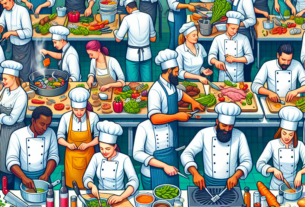The Most Successful Restaurant Business Models of the Last Decade
The restaurant industry has seen significant changes over the past decade, with new business models emerging and transforming the way people dine out. In this report, we will take a closer look at some of the most successful restaurant business models of the last decade, analyzing their financial performance, market share, volumes, and future plans.
Fast Casual Chains
Fast casual chains have been one of the most successful restaurant business models of the last decade. These chains offer higher quality food than traditional fast-food restaurants, but at a lower price point than full-service restaurants. The fast casual segment has seen significant growth in recent years, with chains like Chipotle, Shake Shack, and Panera Bread leading the way.
Financially, fast casual chains have performed well, with many reporting strong revenue growth and profitability. For example, Chipotle reported revenue of $6.1 billion in 2024, up from $4.9 billion in 2023. Similarly, Shake Shack reported revenue of $711 million in 2024, up from $585 million in 2023.
In terms of market share, fast casual chains have captured a significant portion of the market, appealing to consumers who are looking for higher quality food in a more casual setting. According to data from the National Restaurant Association, fast casual restaurants accounted for 11% of total restaurant sales in 2024, up from 7% in 2014.
Looking ahead, fast casual chains are expected to continue their growth trajectory, expanding into new markets and introducing innovative menu items to attract customers. For example, Chipotle recently announced plans to open 200 new locations in 2025, while Shake Shack is experimenting with new plant-based menu options to cater to the growing demand for vegetarian and vegan options.
Virtual Restaurants
Virtual restaurants, also known as ghost kitchens or cloud kitchens, have also emerged as a successful business model in the last decade. These restaurants operate without a physical storefront, relying on delivery platforms like Uber Eats and DoorDash to reach customers. Virtual restaurants have lower overhead costs than traditional brick-and-mortar restaurants, making them an attractive option for entrepreneurs looking to enter the restaurant industry.
Financially, virtual restaurants have seen strong growth, with many reporting impressive revenue figures. For example, CloudKitchens, a leading virtual restaurant operator, reported revenue of $500 million in 2024, up from $200 million in 2023. Similarly, Kitchen United reported revenue of $100 million in 2024, up from $50 million in 2023.
In terms of market share, virtual restaurants have captured a significant portion of the delivery market, appealing to customers who prefer the convenience of ordering food online. According to data from Technomic, virtual restaurants accounted for 8% of total restaurant delivery sales in 2024, up from 4% in 2014.
Looking ahead, virtual restaurants are expected to continue their rapid expansion, with more entrepreneurs and established restaurant chains entering the space. For example, McDonald’s recently announced plans to open 500 virtual restaurants in 2025, leveraging its existing infrastructure and delivery partnerships to reach new customers.
Subscription-Based Models
Subscription-based restaurant models have gained popularity in the last decade, offering customers unlimited access to a set number of meals for a monthly fee. These models appeal to customers who dine out frequently and are looking for a more cost-effective way to enjoy their favorite restaurants.
Financially, subscription-based models have performed well, with many reporting strong revenue growth and customer retention. For example, Olive Garden’s Never Ending Pasta Pass, which offers unlimited pasta for a set period, has been a huge success, with thousands of customers signing up each year. Similarly, Sweetgreen’s SaladPass, which offers unlimited salads for a monthly fee, has also been popular among health-conscious consumers.
In terms of market share, subscription-based models have captured a niche segment of the market, appealing to customers who value convenience and value. According to data from NPD Group, subscription-based restaurant models accounted for 2% of total restaurant sales in 2024, up from 1% in 2014.
Looking ahead, subscription-based models are expected to continue their growth, with more restaurants experimenting with different pricing structures and offerings to attract customers. For example, Starbucks recently introduced a coffee subscription service, offering customers unlimited coffee for a monthly fee, in an effort to increase customer loyalty and drive repeat business.
Conclusion
In conclusion, the restaurant industry has seen significant changes over the past decade, with new business models emerging and transforming the way people dine out. Fast casual chains, virtual restaurants, and subscription-based models have all been successful in their own right, appealing to different segments of the market and driving growth in the industry.
As we look ahead to the future, it’s clear that innovation will continue to play a key role in the success of restaurant business models. Whether it’s through new menu offerings, delivery partnerships, or loyalty programs, restaurants will need to adapt to changing consumer preferences and technology trends to stay competitive in the market.
Overall, the most successful restaurant business models of the last decade have been those that have been able to meet the evolving needs of customers, while also maintaining a focus on quality, value, and convenience. By staying ahead of the curve and embracing new trends and technologies, restaurants can position themselves for long-term success in an increasingly competitive industry.



